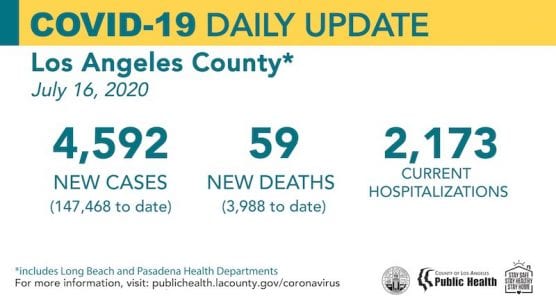The Los Angeles County Department of Public Health confirms 59 new deaths and 4,592 new cases of COVID-19. This is the largest increase in new cases, surpassing the count from Tuesday. Over the last 48 hours there have been 7,350 new cases.
In Santa Clarita, Public Health has confirmed 3,837 cases to date, and 41 deaths.
To date, Public Health has identified 147,468 positive cases of COVID-19 across all areas of L.A. County, and a total of 3,988 deaths. Ninety-three percent of people who died had underlying health conditions.
Statewide, as of July 15, the California Department of Public Health has confirmed a total of 356,178 cases and 7,345 deaths from COVID-19. Currently, there are 6,777 confirmed hospitalizations and 1,897 ICU hospitalizations.
California’s positivity rate – a key indicator of community spread – is trending upward in the 14-day average. Hospitalization rates are also trending upward in the 14-day average. Numbers may not represent true day-over-day change as reporting of test results can be delayed, and the 7-day average more accurately describes trends in number of cases. The 7-day average number of new cases is 8,526 per day. The 7-day average from the week prior was 8,043. As testing capacity continues to increase across the state, an increase in the number of positive cases has been expected – increasing the importance of positivity rates to find signs of community spread.
A total of 32 counties are required to close indoor operations for certain sectors based on the July 13 order to slow community transmission.
Health Care Worker Infection Rates
As of July 15, local health departments have reported 18,533 confirmed positive cases in health care workers and 105 deaths statewide.
Santa Clarita Valley Thursday Update
Of the 3,837 cases reported to Public Health for the SCV to date, the community breakdown is as follows:
City of Santa Clarita: 1,720
Castaic: 1,830 (includes Pitchess Detention Center and North County Correctional Facility*)
Stevenson Ranch: 88
Canyon Country (unincorporated portion): 60
Acton: 37
Val Verde: 35
Valencia (unincorporated portion west of I-5): 27
Agua Dulce: 15
Saugus (unincorporated portion): 11
Elizabeth Lake: 5
Newhall (Unincorporated portion): 4
Sand Canyon: 2
Bouquet Canyon: 1
Lake Hughes: 1
Saugus/Canyon Country: 1
*Note: The county is unable to break out separate numbers for Castaic and PDC/NCCF because the county uses geotagging software that cannot be changed at this time, according to officials. Click here for the LASD COVID-19 dashboard.
Henry Mayo Thursday Update
Henry Mayo Newhall Hospital reported its 15th COVID-related death on Monday, July 13, according to Patrick Moody, hospital spokesman.
Of the 41 SCV residents who have died of the virus to date, 33 resided in the city of Santa Clarita, 2 in Acton, 2 in Castaic, 1 in Val Verde, 1 in unincorporated Valencia, 1 in unincorporated Bouquet Canyon, and 1 in a community not yet named, according to Public Health records.
As of Monday, of the 4,316 people tested at Henry Mayo Newhall Hospital to date, 454 tested positive, 4,010 were negative, 484 were pending, 15 patients were hospitalized in a dedicated unit receiving ICU-level care and a total of 137 COVID-19 patients have been discharged so far, Moody said.
Discrepancies in the testing numbers are due to some patients being tested multiple times. “Often a single patient is tested more than once,” Moody said.
The hospital is now releasing numbers on a weekly basis (Wednesdays) unless there is a drastic change in the number of cases or a death has been confirmed.
 L.A. County
L.A. County
Countywide, of the 59 new deaths, 34 people who died were over the age of 65 years old and 20 people who died were between the ages of 41 and 65 years old. Forty-eight people had underlying health conditions including 32 people over the age of 65 years old and 16 people between the ages of 41 to 65 years old. Five deaths were reported by the city of Long Beach.
Of those who died, information about race and ethnicity is available for 3,701 people (99 percent of the cases reported by Public Health); 46% of deaths occurred among Latino/Latinx residents, 26% among White residents, 15% among Asian residents, 11% among African American/Black residents, less than 1% among Native Hawaiian/Pacific Islander residents and 2% among residents identifying with other races. Upon further investigation, 133 cases and seven deaths reported earlier were not L.A. County residents.
There are 2,173 confirmed cases currently hospitalized, 27% of these people are confirmed cases in the ICU and 17% are confirmed cases on ventilators. Data shows younger people between the ages of 18 and 40 years old are being hospitalized at a higher rate than seen at any point in this pandemic. They comprise of 20% of patients with COVID-19 currently hospitalized.
Testing results are available for over 1,440,000 individuals with 9% of all people testing positive.
“To the families that are grieving the loss of a loved one to COVID-19, we send you our deepest sympathies and prayers every day,” said Barbara Ferrer, PhD, MPH, MEd, Director of Public Health. “This week we’ve hit concerning milestones. We have reported the most cases in a single day, the most hospitalizations and tragically high death numbers. Each case represents a person that is capable of, and in all probability is, infecting at least one other person. If you do the math, it is easy to see why the alarm. In a matter of weeks, the 4,600 positive cases today could lead to over 18,000 infected people in a few weeks. And this is just from one day of new cases. Without aggressive action on the part of every person, we will not get back to slowing the spread.”
Business owners must take immediate action to implement strategies that protect workers and customers. The Health Officer Order to close indoor operations at many businesses must be followed.
The Order requires the closure of the following sectors for all indoor operations:
– Gyms and Fitness Centers
– Places of Worship
– Indoor Protests
– Offices for Non-Critical Infrastructure Sectors as identified at covid19.ca.gov.
– Personal Care Services(including nail salons, massage parlors, and tattoo parlors)
– Hair Salons and Barbershops
– Indoor Malls
Bars, indoor dining at restaurants, indoor museums, indoor operations at zoos and aquariums, and cardrooms and satellite wagering facilities remain closed and all events and gatherings unless specifically allowed by this Order remain prohibited.
Residents need to make sure they are also doing their part. Residents should always wear a face covering securely over their nose and mouth and keep six feet apart from others not in their household when out in public and wash hands frequently. Everyone should avoid the Three Cs: Crowded places, Confined spaces and Close contact with others not in your household. Public Health reminds everyone that you remain safer at home.
It’s important if someone thinks they could be positive for COVID-19 and are awaiting testing results, to stay at home and act as if they are positive. This means self-isolating for 10 days and 72 hours after symptoms and fever subside. If a person tests positive for COVID-19, they should plan on receiving a call from a public health specialist to discuss how to protect themselves and others, to find out where they may have been, and who they were in close contact with while infectious.
The Reopening Protocols, COVID-19 Surveillance Interactive Dashboard, Roadmap to Recovery, Recovery Dashboard, and additional things you can do to protect yourself, your family and your community are on the Public Health website, www.publichealth.lacounty.gov.

California Thursday
There have been 5,915,508 tests conducted in California. This represents an increase of 122,232 over the prior 24-hour reporting period. The California Department of Public Health released updated testing guidance on July 14 that focuses on testing hospitalized individuals with signs or symptoms of COVID-19 and people being tested as part of the investigation and management of outbreaks, including contact tracing. The testing guidance also prioritizes individuals who have COVID-19 symptoms and individuals without symptoms who fall into high-risk categories, including people who live and work in nursing homes, homeless shelters and prisons, healthcare workers, and patients in hospitals. The new guidance will ensure that Californians who most need tests get them even if there are limited supplies.
Data and Tools
A wide range of data and analysis guides California’s response to COVID-19. The state is making the data and its analytical tools available to researchers, scientists and the public at covid19.ca.gov.
Popular links include:
– The Statewide COVID-19 Dashboard
– The California COVID-19 Assessment Tool (CalCAT)
– State Cases and Deaths Associated with COVID-19 by Age Group
– COVID-19 Race & Ethnicity Data
– COVID-19 Hospital Data and Case Statistics
– View additional datasets at the California Open Data Portal (Including: Testing Data, PPE Logistics Data, Hospital Data, Homeless Impact and more)
County Monitoring Data
California is using data and science to respond to COVID-19. Data by county gives Californians insight into how their county is doing and provides an early indication of developing areas of concern. Counties on the County Monitoring List for three or more consecutive days – currently 32 counties accounting for 80 percent of the state’s population – must close indoor operations for additional activities.

For more information, County Data Monitoring page.
Racial Demographics – A More Complete Picture
The California Department of Public Health is committed to health equity and collecting more detailed racial and ethnic data that will provide additional understanding for determining future action. Health outcomes are affected by forces including structural racism, poverty and the disproportionate prevalence of underlying conditions such as asthma and heart disease among Latinos and African American Californians. Only by looking at the full picture can we understand how to ensure the best outcomes for all Californians.
The differences in health outcomes related to COVID-19 are most stark in COVID-19 deaths. We have nearly complete data on race and ethnicity for COVID-19 deaths, and we are seeing the following trends. Overall, for adults 18 and older, Latinos, African Americans and Native Hawaiians and Pacific Islanders are dying at disproportionately higher levels. The proportion of COVID-19 deaths in African Americans is about double their population representation across all adult age categories. For Native Hawaiians and Pacific Islanders, overall numbers are low, but about three-fold difference between the proportion of COVID-19 deaths and their population representation. More males are dying from COVID-19 than females, in line with national trends. More information is available at COVID-19 Race and Ethnicity Data.
New Data Portal
The state has launched a new, user-friendly data portal at COVID-19 Statewide Update that tracks COVID-19 cases statewide and by county, gender, age and ethnicity. The portal also outlines statewide hospitalizations and testing efforts. The data presented on the portal will be updated daily and will include additional information as it is available.
Your Actions Save Lives
Every person has a role to play. Protecting yourself and your family comes down to common sense:
– Staying home except for essential needs/activities following local and state public health guidelines when patronizing approved businesses. To the extent that such sectors are re-opened, Californians may leave their homes to work at, patronize, or otherwise engage with those businesses, establishments or activities.
– Practicing social distancing.
– Wearing a cloth face mask when out in public.
– Washing hands with soap and water for a minimum of 20 seconds.
– Avoiding touching eyes, nose or mouth with unwashed hands.
– Covering a cough or sneeze with your sleeve, or disposable tissue. Wash your hands afterward.
– Avoiding close contact with people who are sick.
– Staying away from work, school or other people if you become sick with respiratory symptoms like fever and cough.
– Following guidance from public health officials.
Always check with trusted sources for the latest accurate information about novel coronavirus:
– Los Angeles County Department of Public Health
– California Department of Public Health
– Centers for Disease Control and Prevention
– Spanish
– World Health Organization
L.A. County residents can also call 2-1-1.
What to Do if You Think You’re Sick
Call ahead: If you are experiencing symptoms of COVID-19 (fever, cough or shortness of breath), call your health care provider before seeking medical care so that appropriate precautions can be taken. More than 85 community testing sites also offer free, confidential testing: Find a COVID-19 Testing Site.
For more information about what Californians can do to prevent the spread of COVID-19, visit Coronavirus (COVID-19) in California.
California continues to issue guidance on preparing and protecting California from COVID-19. Consolidated guidance is available on the California Department of Public Health’s Guidance webpage.
To view the Los Angeles County Incident Report for Thursday, see below:
[Open .pdf in new window]
Like this:
Like Loading...
Related





 Tweet This
Tweet This Facebook
Facebook Digg This
Digg This Bookmark
Bookmark Stumble
Stumble RSS
RSS




























REAL NAMES ONLY: All posters must use their real individual or business name. This applies equally to Twitter account holders who use a nickname.
0 Comments
You can be the first one to leave a comment.